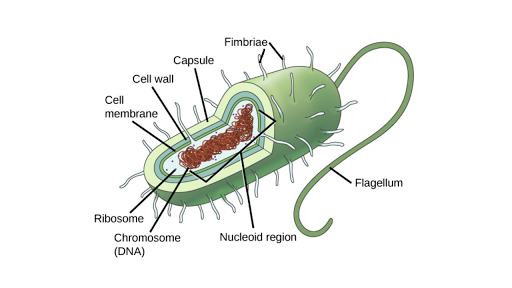Prokaryotic cells have a lower degree of complexity than eukaryotic cells. Prokaryotic cells and eukaryotic cells reproduce by meiosis.

Prokaryotic Cell Definition Examples Structure Biology Dictionary
A cell that contains a membrane-bound nucleus B.

. According to the central dogma of life the DNA stores the genetic information to produce. 40 chromosomes each consisting of two chromatids 80 chromosomes each consisting of two chromatids 40 chromosomes each consisting of one chromatid. In this case a bacterium.
A cell that does not contain any membrane-bound organelles C. A cell that is not surrounded by a cell membrane. After a mitotic division is complete a daughter cell has 40 chromosomes.
All Eukaryotic organisms consist of a single cell most do but there are many multicellular organisms-like us E. Proteins DNA RNA. A cell membrane A chromosomal DNA that is concentrated in a nucleoid A ribosomes and.
Which of the following best describes the flow of information in eukaryotic cells. Which of the following best describes a eukaryotic cell. D Water will move into the cell.
RNA proteins DNA B. Prokaryotic cells are thus more primitive than eukaryotic cells which evolved from them. The figure above shows an organelle mitochondria typically found in eukaryotic cells.
The mRNA is synthesized in a 5to 3direction. Eukaryotic Cells are larger and more complex than Prokaryotic Cells Yes this is true about Eukaryotic cells. Prokaryotic cells do not have a true nucleus or membrane-bound organelles.
Protein synthesis in a prokaryotic cell Which of the following best describes a characteristic of the process shown in Figure 1 that is unique to prokaryotes. DNA proteins RNA C. DNA proteins RNA.
There are three evolutionary domains of life. A ionic bondsB nonpolar. Which of the following best describes the flow of information in eukaryotic cells.
Which of the following statements best describes an exergonic reaction. DNA RNA proteins D. 9 Which of the followingbestdescribes the flow of information in eukaryotic cellsA DNARNAproteins B RNAproteinsDNA 9 C proteinsDNARNA D RNADNAproteins E DNAproteinsRNA 10 Which type of bond must be broken for water to vaporize.
Prokaryotic cells have membrane-bound organelles and eukaryotic cells do not have membrane-bound organelles. A typical prokaryotic cell contains the following. 3 Which of the following statements best describes what happens when a bacterial cell is placed in a solution containing 5 NaCl.
The inner membrane has specialized proteins that create a hydrogen ion concentration gradient between the intermembrane space and the matrix. A cell that is surrounded by a rigid cell wall D. RNA DNA proteins E.
Prokaryotic cells do not have a true nucleus that contains their genetic material as eukaryotic cells do. Organisms that are classified in the Bacteria and Archaea domains are prokaryotic cells. O A Chromatin-remodeling complexes reposition the nucleosomes to allow the transcription factors and RNA polymerase to bind the promoter and initiate transcription OB.
Prokaryotic cells are generally larger than eukaryotic cells. Which of the following best describes the cell below. D DNA RNA proteins.
The reaction proceeds with a net release of free energy. Which of the following best describes the different levels of gene regulation in eukaryotic cells. В A single strand of the DNA is being used as a template for the transcription of the mRNA.
These cells are much simpler than eukaryotic cells in terms of cytoplasmic organization. Therefore the statement that best describes prokaryotic cells are those cells that does not contain membrane-bound organelles. Proteins DNA RNA D.
A cell lacking a membrane-bounded nucleus or membrane-bounded organelles. Which of the following best describes the function of the double membrane system of this organelle. Eukaryotic cells contain membrane-bound organelles while prokaryotic cells do not.
RNA proteins DNA C. Group of answer choices A. The following image is a diagram of a prokaryotic cell.
Eukaryotic cells are the only type of cells that can possess a cell wall. The Anatomy of a Bacterial Cell Prokaryotic Cell Structure. Both A and B are statements that correctly describe Eukaryotic cells.
The translation of the mRNA is occurring while the. Prokaryotic Cell Diagram. ATP molecules serve as the primary means by which cells.
A Sucrose will move into the cell from a higher to a lower concentration. B The cell will undergo osmotic lysis. Dec 5 2014.
Addition of methyl groups to the tails of the histones cause histones. C Water will move out of the cell. Prokaryotic cells are all viruses and rely on the infection of a host cell to replicate.
Evolution has occurred in accordance with the laws of thermodynamics and resulted in an increase in the entropy of the universe. Bacteria Archaea and Eukarya. Which of the following best describes the chromosome composition of the mother cell in the G2 phase.
Eukaryotic cells are only found in protists bacteria and viruses. 9 which of the following best describes the flow of. RNA DNA proteins E.
DNA RNA proteins B.

Prokaryotic Cell Definition Examples Structure Biology Dictionary

Best Answer Which Of The Following Best Describes A Prokaryotic Cell A A Cell That Contains A Brainly Com

0 Comments